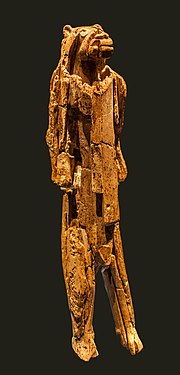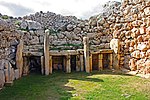initial excavation of the Szeletian cave was carried out from 1906 to 1913 by Ottocar Kadić. The idea of a distinctive Szeletian culture was advocated by...
5 KB (494 words) - 20:13, 27 August 2024
Mousterian Levallois technique, as do the contemporary assemblages of the Szeletian (centered on the Bükk Mountains of Hungary but also present in southern...
4 KB (296 words) - 15:37, 25 July 2024
Europe: 33,000 BP, Gravettian culture in southern Ukraine 30,000 BP, Szeletian culture 22,000 BP, Pavlovian, Aurignacian cultures 13,000 BP, Ahrensburg...
45 KB (4,699 words) - 21:10, 21 October 2024
transitional cultures (Uluzzian in Italy and Greece, Altmühlian in Germany, Szeletian in Central Europe and Châtelperronian in the southwest) use clearly Upper...
195 KB (23,019 words) - 00:06, 2 November 2024
Lincombian-Ranisian-Jerzmanowician (43–32 ka) Aurignacian (43–26 ka) Szeletian (41,000-37,000) Périgordian (35–20 ka) Gravettian (33–24 ka) Pavlovian...
107 KB (11,383 words) - 14:54, 29 September 2024
archeological culture in Western Europe and several local industries like the Szeletian in Eastern Europe/Eurasia. There is no evidence for Neanderthals in Africa...
80 KB (10,300 words) - 07:11, 1 November 2024
transitional cultures include the Italian Uluzzian industry, and the Balkan Szeletian industry. Before immigration, the only evidence of Neanderthal bone tools...
334 KB (36,296 words) - 00:03, 27 October 2024
for Gravettian genesis include evolution: in central Europe from the Szeletian (which developed from the Bohunician) which existed 41,000 to 37,000 years...
154 KB (19,167 words) - 14:44, 23 October 2024
Lincombian-Ranisian-Jerzmanowician (43–32 ka) Aurignacian (43–26 ka) Szeletian (41,000-37,000) Périgordian (35–20 ka) Gravettian (33–24 ka) Pavlovian...
43 KB (4,853 words) - 17:37, 23 October 2024
Upper Paleolithic cultures from central and western Europe such as the Szeletian culture. This initial cultural development might be attributable to local...
17 KB (1,693 words) - 16:35, 16 April 2024









